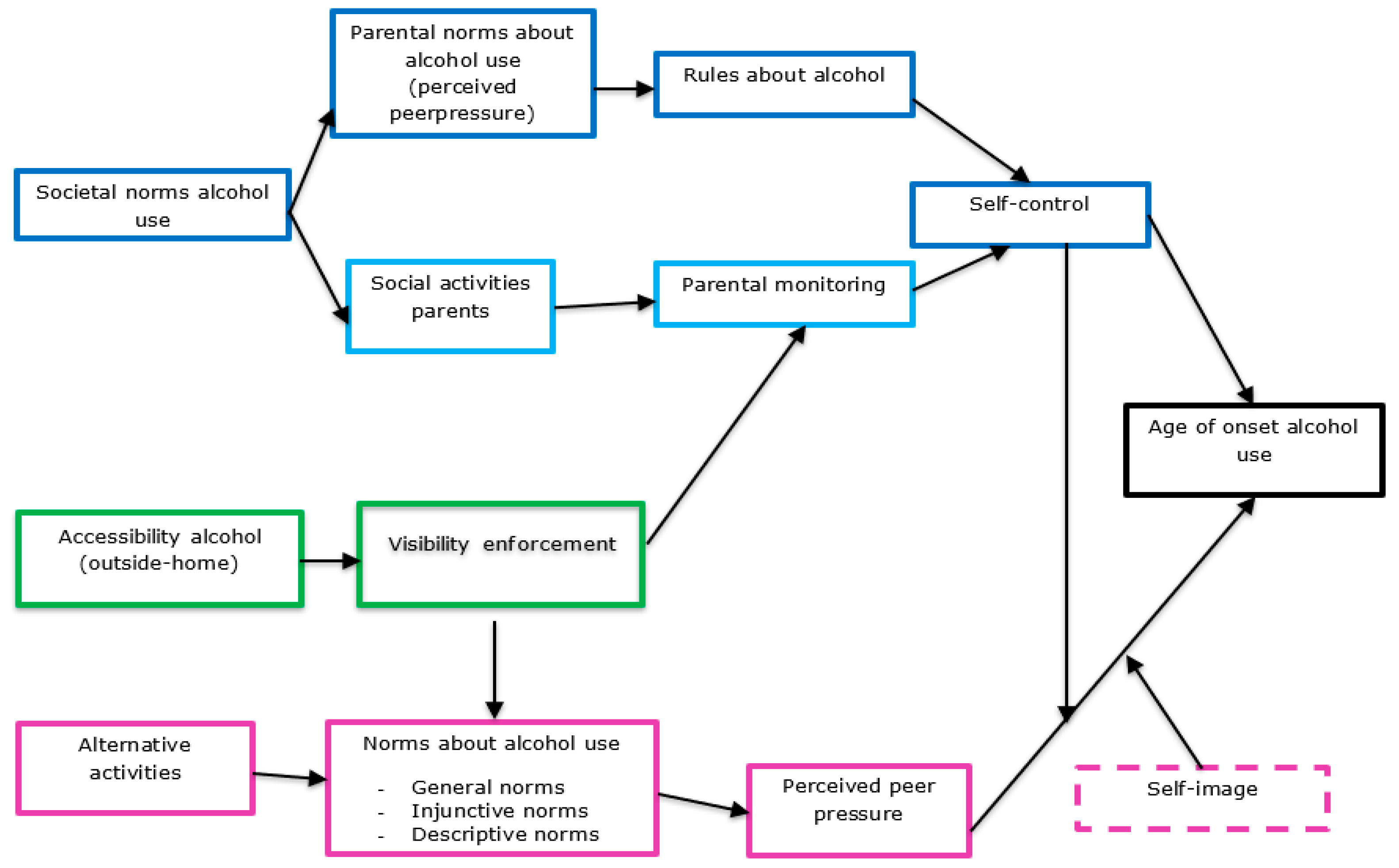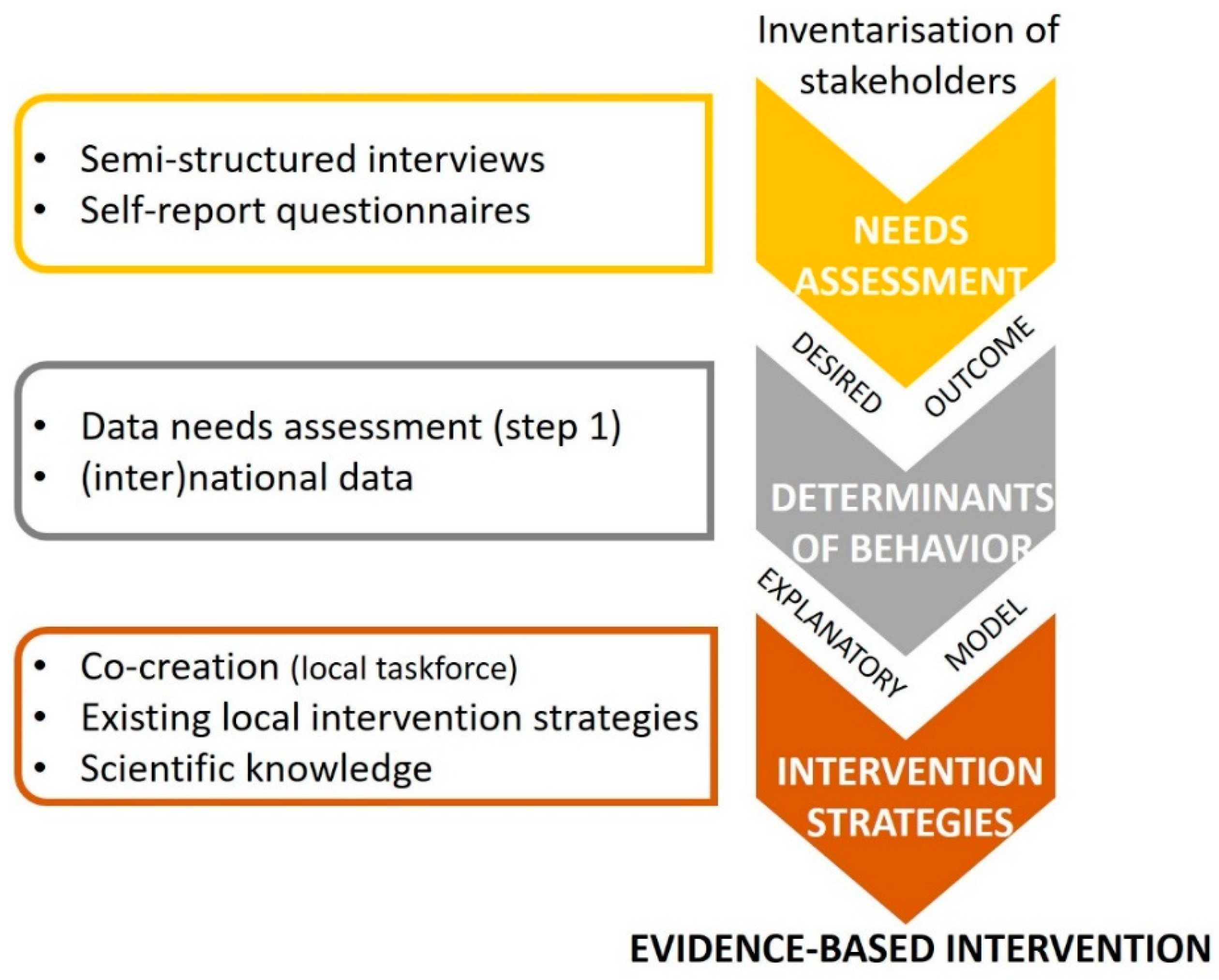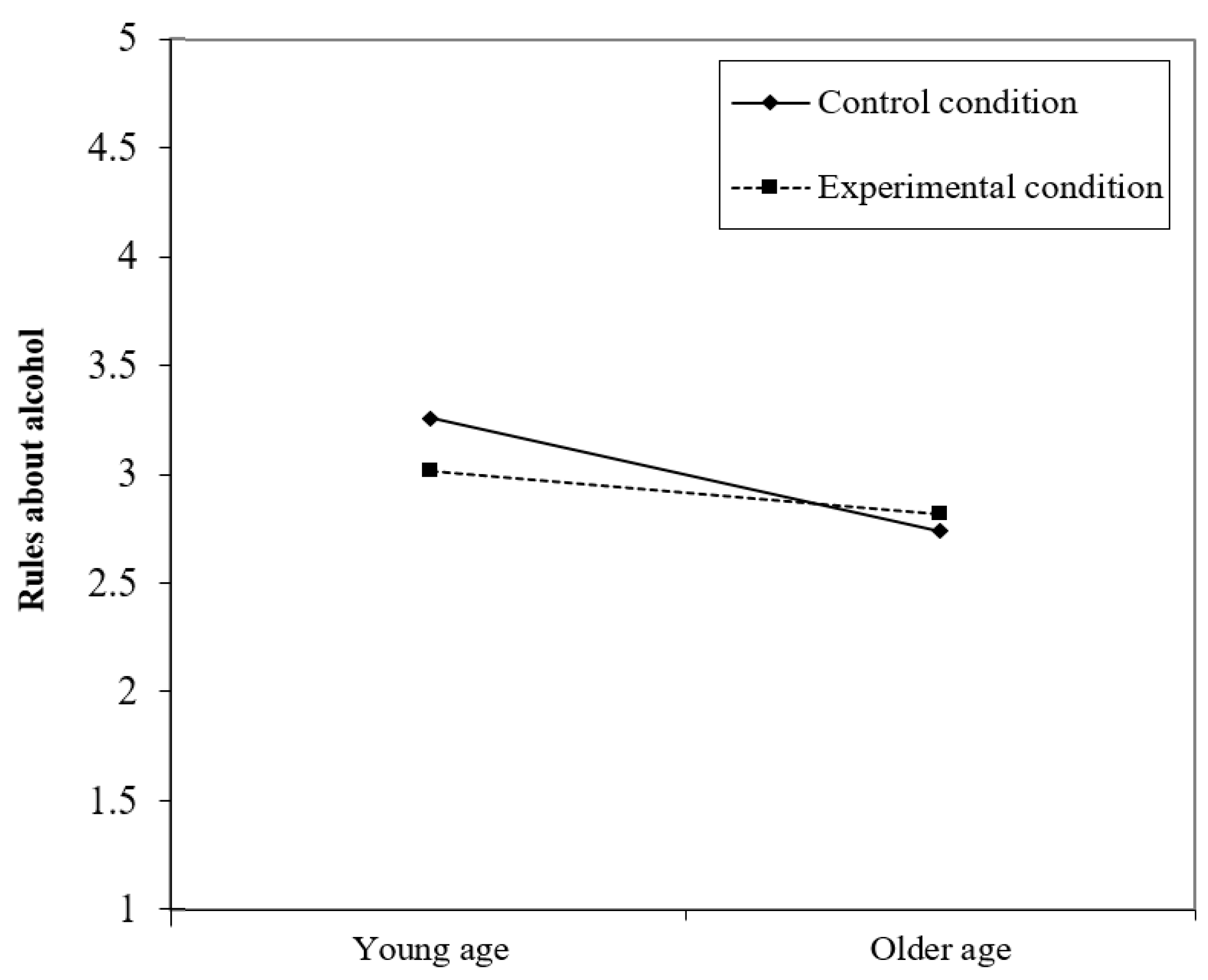Pre-Intervention Effects of a Community-Based Intervention Targeting Alcohol Use (LEF); The Role of Participatory Research and Publicity
Abstract
1. Introduction
2. Methods
2.1. Procedure
2.2. Intervention: Participatory Development of a Community-Based Intervention
2.3. Sample
2.4. Loss to Follow-Up
2.5. Measures
2.6. Data Analysis
3. Results
3.1. Main Effects
3.2. Moderation Effects
4. Discussion
Strengths and Limitations
5. Conclusions
Author Contributions
Funding
Institutional Review Board Statement
Informed Consent Statement
Data Availability Statement
Acknowledgments
Conflicts of Interest
References
- ESPAD. ESPAD Report 2019: Results from the European School Survey Project on Alcohol and Other Drugs; Publications Office of the European Union: Luxembourg, 2020. [Google Scholar]
- Inchley, J.; Currie, D.; Budisavljevic, S.; Torsheim, T.; Jåstad, A.; Cosma, A.; Arnarsson, A. (Eds.) Spotlight on Adolescent Health and Well-Being. Findings from the 2017/2018 Health Behaviour in School-Aged Children (HBSC) Survey in Europe and Canada. International Report. Volume 1. Key Findings; WHO Regional Office for Europe: Copenhagen, Denmark, 2020. [Google Scholar]
- Rombouts, M.; Van Dorsselaer, S.; Scheffers-van Schayk, T.; Tuithof, M.; Kleinjan, M.; Monshouwer, K. Jeugd en Riskant Gedrag 2019. Kerncijfers uit Het Peilstationsonderzoek Scholieren; Trimbos-instituut: Utrecht, The Netherlands, 2020. [Google Scholar]
- Stevens, G.; Van Dorsselaer, S.; Boer, M.; De Roos, S.; Duinhof, E.; Ter Bogt, T.; van den Eijnden, R.J.J.M.; Kuyper, L.; Visser, D.; Vollebergh, W.A.M.; et al. HBSC 2017. Gezondheid en Welzijn van Jongeren in Nederland; Utrecht University: Utrecht, The Netherlands, 2018. [Google Scholar]
- De Looze, M.; Raaijmakers, Q.A.W.; Ter Bogt, T.; Bendtsen, P.; Farhat, T.; Ferreira, M.; Godeau, E.; Kuntsche, E.; Molcho, M.; Pförtner, T.-K.; et al. Decreases in adolescent weekly alcohol use in Europe and North America: Evidence from 28 countries from 2002 to 2010. Eur. J. Public Health 2015, 25, 69–72. [Google Scholar] [CrossRef]
- Van Laar, M.W.; Cruts, A.N.N.; van Ooyen-Houben, M.M.J.; Meijer, R.F.; Brunt, T. Nationale Drug Monitor Jaarbericht 2009; Trimbos-Instituut: Utrecht, The Netherlands, 2010. [Google Scholar]
- Jeanblanc, J. Comorbidity between Psychiatric Diseases and Alcohol Use Disorders: Impact of Adolescent Alcohol Consumption. Curr. Addict. Rep. 2015, 2, 293–301. [Google Scholar] [CrossRef]
- Jessor, R. Problem Behavior Theory: A half century of research on adolescent behavior and development. In The Developmental Science of Adolescence: History through Autobiography; Psychology Press: East Sussex, UK, 2014; pp. 239–256. [Google Scholar]
- Roebroek, L.; Koning, I.M. The Reciprocal Relation Between Adolescents’ School Engagement and Alcohol Consumption, and the Role of Parental Support. Prev. Sci. 2015, 17, 218–226. [Google Scholar] [CrossRef]
- Stockings, E.; Bartlem, K.; Hall, A.; Hodder, R.; Gilligan, C.; Wiggers, J.H.; Sherker, S.; Wolfenden, L. Whole-of-community interventions to reduce population-level harms arising from alcohol and other drug use: A systematic review and meta-analysis. Addiction 2018, 113, 1984–2018. [Google Scholar] [CrossRef]
- Bronfenbrenner, U. The Ecology of Human Development: Experiments by Nature and Design; Harvard University Press: Cambridge, MA, USA, 1979. [Google Scholar]
- Kuntsche, E.; Knibbe, R.; Gmel, G.; Engels, R. Why do young people drink? A review of drinking motives. Clin. Psychol. Rev. 2005, 25, 841–861. [Google Scholar] [CrossRef]
- Stewart, C.; Power, T.G. Identifying patterns of adolescent drinking: A tri-ethnic study. J. Stud. Alcohol 2002, 63, 156–168. [Google Scholar] [CrossRef]
- Wold, B.; Mittelmark, M.B. Health-promotion research over three decades: The social-ecological model and challenges in implementation of interventions. Scand. J. Public Health 2018, 46, 20–26. [Google Scholar] [CrossRef] [PubMed]
- Koning, I.M.; Vollebergh, W.A.M.; Smit, F.; Verdurmen, J.E.E.; Van den Eijnden, R.J.J.M.; Ter Bogt, T.F.M.; Stattin, H.; Engels, R.C.M.E. Preventing heavy alcohol use in adolescents (PAS): Cluster randomized trial of a parent and student intervention offered separately and simultaneously. Addiction 2009, 104, 1669–1678. [Google Scholar] [CrossRef] [PubMed]
- Koning, I.M.; Eijnden, R.J.V.D.; Verdurmen, J.E.; Engels, R.; Vollebergh, W.A. Long-Term Effects of a Parent and Student Intervention on Alcohol Use in Adolescents: A Cluster Randomized Controlled Trial. Am. J. Prev. Med. 2011, 40, 541–547. [Google Scholar] [CrossRef] [PubMed]
- Smit, E.; Verdurmen, J.; Monshouwer, K.; Smit, F. Family interventions and their effect on adolescent alcohol use in general populations; a meta-analysis of randomized controlled trials. Drug Alcohol Depend. 2008, 97, 195–206. [Google Scholar] [CrossRef] [PubMed]
- Foxcroft, D.R.; Tsertsvadze, A. Universal school-based prevention programs for alcohol misuse in young people. Cochrane Database Syst. Rev. 2011, CD009113. [Google Scholar] [CrossRef]
- EMCDDA. Environmental Substance Use Prevention Interventions in Europe. 2018. Available online: https://www.emcdda.europa.eu/publications/technical-reports/environmental-substance-use-prevention-interventions-in-europe_en (accessed on 26 November 2020).
- Stockings, E.; Shakeshaft, A.; Farrell, M. Community Approaches for Reducing Alcohol-Related Harms: An Overview of Intervention Strategies, Efficacy, and Considerations for Future Research. Curr. Addict. Rep. 2018, 5, 274–286. [Google Scholar] [CrossRef]
- O’Mara-Eves, A.; Brunton, G.; McDaid, D.; Oliver, S.; Kavanagh, J.; Jamal, F.; Matosevic, T.; Hardenberg, A.; Thomas, J. Community engagement to reduce inequalities in health: A systematic review, meta-analysis and economic analysis. Public Health Res. 2013, 1, 1–526. [Google Scholar] [CrossRef]
- Gaventa, J.; Cornwall, A. Challenging the Boundaries of the Possible: Participation, Knowledge and Power. IDS Bull. 2006, 37, 122–128. [Google Scholar] [CrossRef]
- Minkler, M.; Wallerstein, N. Community-Based Participatory Research for Health: From Process to Outcomes; John Wiley & Sons: San Francisco, CA, USA, 2011. [Google Scholar]
- World Health Organization. Ottawa Charter for Health Promotion; World Health Organization: Geneva, Switzerland, 1986. [Google Scholar]
- Milton, B.; Attree, P.; French, B.; Povall, S.; Whitehead, M.; Popay, J. The impact of community engagement on health and social outcomes: A systematic review. Community Dev. J. 2011, 47, 316–334. [Google Scholar] [CrossRef]
- O’Mara-Eves, A.; Brunton, G.; Oliver, S.; Kavanagh, J.; Jamal, F.; Thomas, J. The effectiveness of community engagement in public health interventions for disadvantaged groups: A meta-analysis. BMC Public Health 2015, 15, 129. [Google Scholar] [CrossRef]
- McConnell, M.; Memetovic, J.; Richardson, C. Coping style and substance use intention and behavior patterns in a cohort of BC adolescents. Addict. Behav. 2014, 39, 1394–1397. [Google Scholar] [CrossRef]
- Jagosh, J.; Macaulay, A.C.; Pluye, P.; Salsberg, J.; Bush, P.; Henderson, J.; Sirett, E.; Wong, G.; Cargo, M.; Herbert, C.P.; et al. Uncovering the Benefits of Participatory Research: Implications of a Realist Review for Health Research and Practice. Milbank Q. 2012, 90, 311–346. [Google Scholar] [CrossRef] [PubMed]
- Fagan, A.A.; Arthur, M.W.; Hanson, K.; Briney, J.S.; Hawkins, J.D. Effects of Communities That Care on the Adoption and Implementation Fidelity of Evidence-Based Prevention Programs in Communities: Results from a Randomized Controlled Trial. Prev. Sci. 2011, 12, 223–234. [Google Scholar] [CrossRef] [PubMed][Green Version]
- Koning, I.M.; De Kock, C.; van der Kreeft, P.; Percy, A.; Sanchez, Z.M.; Burkhart, G. Implementation of the Icelandic Prevention Model: A critical discussion of its worldwide transferability. Drugs Educ. Prev. Policy 2020, 1–12. [Google Scholar] [CrossRef]
- Sawyer, S.M.; Afifi, R.A.; Bearinger, L.H.; Blakemore, S.-J.; Dick, B.; Ezeh, A.C.; Patton, G.C. Adolescence: A foundation for future health. Lancet 2012, 379, 1630–1640. [Google Scholar] [CrossRef]
- Koning, I.M.; Van der Rijst, V.G. Programma LEF: Het Uitstellen van het Beginnen Met Drinken Onder Minderjarige Jongeren in Edam-Volendam. Rapportage Probleemdefinitie. 2018. Available online: https://www.lef-edvo.nl/wp-content/uploads/2019/03/Bijlage-1-Onderzoeksrapport-programma-LEF.pdf (accessed on 8 February 2021).
- Brody, G.H.; Flor, D.L.; Hollett-Wright, N.; McCoy, J.K.; Donovan, J. Parent-child relationships, child temperament profiles and children’s alcohol use norms. J. Stud. Alcohol Suppl. 1999, 45–51. [Google Scholar] [CrossRef]
- Van Der Vorst, H.; Engels, R.C.; Meeus, W.; Deković, M. The impact of alcohol-specific rules, parental norms about early drinking and parental alcohol use on adolescents’ drinking behavior. J. Child Psychol. Psychiatry 2006, 47, 1299–1306. [Google Scholar] [CrossRef]
- Van Der Vorst, H.; Engels, R.; Meeus, W.; Deković, M.; Van Leeuwe, J. The role of alcohol-specific socialization in adolescents’ drinking behaviour. Addiction 2005, 100, 1464–1476. [Google Scholar] [CrossRef]
- Engels, R.C.; Knibbe, R.A. Alcohol use and intimate relationships in adolescence: When love comes to town. Addict. Behav. 2000, 25, 435–439. [Google Scholar] [CrossRef]
- Engels, R.; Knibbe, R.A.; Drop, M.J. Why Do Late Adolescents Drink at Home? A Study on Psychological Well-Being, Social Integration and Drinking Context. Addict. Res. 1999, 7, 31–46. [Google Scholar] [CrossRef]
- Muthén, L.K.; Muthén, B.O. Mplus User’s Guide, 7th ed.; Muthén & Muthén: Los Angeles, CA, USA, 1998–2015. [Google Scholar]
- Long, J.S. Regression Models for Categorical and Limited Dependent Variables. J. Am. Stat. Assoc. 1997, 92, 1655. [Google Scholar] [CrossRef]
- Nieminen, P.; Lehtiniemi, H.; Vähäkangas, K.; Huusko, A.; Rautio, A. Standardised regression coefficient as an effect size index in summarising findings in epidemiological studies. Epidemiol. Biostat. Public Health 2013, 10, 1–15. [Google Scholar]
- Schulenberg, J.; Maggs, J.L. A developmental perspective on alcohol use and heavy drinking during adolescence and the transition to young adulthood. J. Stud. Alcohol Suppl. 2002, 54–70. [Google Scholar] [CrossRef] [PubMed]
- Ajzen, I. The theory of planned behavior. Organ. Behav. Hum. Decis. Process. 1991, 50, 179–211. [Google Scholar] [CrossRef]
- Rimal, R.N.; Real, K. How Behaviors are Influenced by Perceived Norms: A test of the theory of normative social behavior. Commun. Res. 2005, 32, 389–414. [Google Scholar] [CrossRef]
- Sznitman, S.R.; Kolobov, T.; ter Bogt, T.; Kuntsche, E.; Walsh, S.D.; Boniel-Nissim, M.; Harel-Fisch, Y. Exploring substance use normalization among adolescents: A multilevel study in 35 countries. Soc. Sci. Med. 2013, 97, 143–151. [Google Scholar] [CrossRef]
- Dono, J.; Miller, C.; Ettridge, K.; Wilson, C. The role of social norms in the relationship between anti-smoking advertising campaigns and smoking cessation: A scoping review. Health Educ. Res. 2020, 35, 179–194. [Google Scholar] [CrossRef] [PubMed]
- Festinger, L. A Theory of Social Comparison Processes. Hum. Relat. 1954, 7, 117–140. [Google Scholar] [CrossRef]
- Linkenbach, J.W.; Perkins, H.W.; DeJong, W. Parents’ perceptions of parenting norms: Using the social norms approach to reinforce effective parenting. In The Social Norms Approach to Preventing School and College Age Substance Abuse: A Handbook for Educators, Counselors, and Clinicians; Perkins, H.W., Ed.; Jossey-Bass: San Francisco, CA, USA, 2003; pp. 247–258. [Google Scholar]
- Labrie, J.W.; Hummer, J.F.; Lac, A.; Ehret, P.J.; Kenney, S.R. Parents Know Best, But Are They Accurate? Parental Normative Misperceptions and Their Relationship to Students’ Alcohol-Related Outcomes. J. Stud. Alcohol Drugs 2011, 72, 521–529. [Google Scholar] [CrossRef] [PubMed]
- Southwell, B.; Yzer, M. The Roles of Interpersonal Communication in Mass Media Campaigns. Ann. Int. Commun. Assoc. 2007, 31, 420–462. [Google Scholar] [CrossRef]
- Jeong, M.; Bae, R.E. The Effect of Campaign-Generated Interpersonal Communication on Campaign-Targeted Health Outcomes: A Meta-Analysis. Health Commun. 2017, 33, 988–1003. [Google Scholar] [CrossRef] [PubMed]
- Friese, B.; Grube, J.; Moore, R. How Parents of Adolescents Store and Monitor Alcohol in the Home. J. Prim. Prev. 2012, 33, 79–83. [Google Scholar] [CrossRef]
- Kaynak, Ö.; Winters, K.C.; Cacciola, J.; Kirby, K.; Arria, A. Providing Alcohol for Underage Youth: What Messages Should We Be Sending Parents? J. Stud. Alcohol Drugs 2014, 75, 590–605. [Google Scholar] [CrossRef]
- Sharmin, S.; Kypri, K.; Khanam, M.; Wadolowski, M.; Bruno, R.; Mattick, R.P. Parental Supply of Alcohol in Childhood and Risky Drinking in Adolescence: Systematic Review and Meta-Analysis. Int. J. Environ. Res. Public Health 2017, 14, 287. [Google Scholar] [CrossRef]
- Van Hoof, J.J.; Van Zanten, E.; Van Der Lely, N. Four Years of Reports of Alcohol-Related Harm to Pediatricians in the Netherlands. J. Child Adolesc. Subst. Abus. 2015, 24, 191–197. [Google Scholar] [CrossRef]
- Paschall, M.J.; Grube, J.W.; Thomas, S.; Cannon, C.; Treffers, R. Relationships Between Local Enforcement, Alcohol Availability, Drinking Norms, and Adolescent Alcohol Use in 50 California Cities. J. Stud. Alcohol Drugs 2012, 73, 657–665. [Google Scholar] [CrossRef] [PubMed]
- Van Hoof, J.J.; Gosselt, J.F. Underage alcohol sales—It only takes a minute: A new approach to underage alcohol availability. J. Stud. Alcohol Drugs 2013, 74, 423–427. [Google Scholar] [CrossRef] [PubMed]
- Moffitt, T.E. Adolescence-limited and life-course-persistent antisocial behavior: A developmental taxonomy. Psychol. Rev. 1993, 100, 674–701. [Google Scholar] [CrossRef]
- Minary, L.; Trompette, J.; Kivits, J.; Cambon, L.; Tarquinio, C.; Alla, F. Which design to evaluate complex interventions? Toward a methodological framework through a systematic review. BMC Med. Res. Methodol. 2019, 19, 92. [Google Scholar] [CrossRef]
- Pawson, R. The Science of Evaluation: A Realist Manifesto. Sage, 2013. Available online: https://uk.sagepub.com/en-gb/eur/the-science-of-evaluation/book238842 (accessed on 19 March 2021).
- Kemm, J. The limitations of ‘evidence-based’ public health. J. Eval. Clin. Pract. Spec. Issue Evid. Based Med. 2006, 12, 319–324. [Google Scholar] [CrossRef]
- Sharp, N.D.; Pineros, S.L.; Hsu, C.; Starks, H.; Sales, A. A Qualitative Study to Identify Barriers and Facilitators to Implementation of Pilot Interventions in the Veterans Health Administration (VHA) Northwest Network. Worldviews Evid.-Based Nurs. 2004, 1, 129–139. [Google Scholar] [CrossRef] [PubMed]



| Control Condition (N = 1027) | Experimental Condition (N = 1137) | Total (N = 2146) | |
|---|---|---|---|
| M (SD) | M (SD) | M (SD) | |
| TN variables | |||
| Age (M,SD) | 14.57 (1.34) | 14.75 (1.32) * | 14.67 (1.33) |
| Gender (% boys) | 49.9% | 46.2% | |
| Norms about alcohol in youth Tn (M,SD) | 2.00 (1.14) | 2.22 (1.28) * | 2.12 (1.19) |
| Rules about alcohol Tn (M,SD) | 3.90 (1.29) | 3.66 (1.41) * | 3.78 (1.36) |
| Informal accessibility of alcohol Tn (M,SD) | 3.20 (1.21) | 2.97 (1.34) * | 3.08 (1.29) |
| Formal accessibility of alcohol Tn (M,SD) | 3.84 (1.36) | 3.48 (1.53) * | 3.65 (1.46) |
| Weekly drinking Tn (M,SD) | 1.98 (5.17) | 3.61 (8.37) * | 2.86 (7.13) |
| T0 variables | |||
| Norms about alcohol in youth T0 (M,SD) | 1.93 (1.06) | 2.04 (1.14) | 1.99 (1.10) |
| Rules about alcohol T0 (M,SD) | 4.05 (1.17) | 3.93 (1.23) | 3.99 (1.19) |
| Informal accessibility of alcohol T0 (M,SD) | 3.12 (1.13) | 2.94 (1.25) * | 3.03 (1.19) |
| Formal accessibility of alcohol T0 (M,SD) | 3.78 (1.30) | 3.48 (1.47) * | 3.63 (1.39) |
| Weekly drinking T0 (M,SD) | 1.42 (4.96) | 2.14 (4.97) * | 1.79 (4.97) |
| Variable | Norms about Youth Drinking T1 | Rules about Alcohol T1 | Informal Accessibility Alcohol T1 | Formal Accessibility Alcohol T1 | Weekly Drinking T1 | |||||
|---|---|---|---|---|---|---|---|---|---|---|
| β(SE) | p-Value | β(SE) | p-Value | β(SE) | p-Value | β(SE) | p-Value | β(SE) | p-Value | |
| Age | 0.37(0.04) | 0.00 | −0.33(0.03) | 0.00 | −0.27(0.03) | 0.00 | −0.21(0.00) | 0.00 | 0.68(0.09) | 0.00 |
| Gender (0 = girls, 1 = boy) | −0.05(0.02) | 0.03 | 0.02(0.02) | 0.23 | −0.02(0.02) | 0.46 | 0.00(0.99) | 0.99 | −0.04(0.08) | 0.57 |
| Outcome T0 | 0.43(0.03) | 0.00 | 0.59(0.03) | 0.00 | 0.39(0.03) | 0.00 | 0.39(0.02) | 0.00 | 0.65(0.10) | 0.00 |
| Condition (1 = experiment) | −0.02(0.02) | 0.30 | 0.02(0.02) | 0.43 | −0.03(0.02) | 0.20 | −0.05(0.04) | 0.04 | 0.28(0.07) | 0.00 |
Publisher’s Note: MDPI stays neutral with regard to jurisdictional claims in published maps and institutional affiliations. |
© 2021 by the authors. Licensee MDPI, Basel, Switzerland. This article is an open access article distributed under the terms and conditions of the Creative Commons Attribution (CC BY) license (https://creativecommons.org/licenses/by/4.0/).
Share and Cite
Koning, I.M.; Van der Rijst, V.G.; De Wit, J.B.F.; De Kock, C. Pre-Intervention Effects of a Community-Based Intervention Targeting Alcohol Use (LEF); The Role of Participatory Research and Publicity. Int. J. Environ. Res. Public Health 2021, 18, 8823. https://doi.org/10.3390/ijerph18168823
Koning IM, Van der Rijst VG, De Wit JBF, De Kock C. Pre-Intervention Effects of a Community-Based Intervention Targeting Alcohol Use (LEF); The Role of Participatory Research and Publicity. International Journal of Environmental Research and Public Health. 2021; 18(16):8823. https://doi.org/10.3390/ijerph18168823
Chicago/Turabian StyleKoning, Ina M., Vincent G. Van der Rijst, John B. F. De Wit, and Charlotte De Kock. 2021. "Pre-Intervention Effects of a Community-Based Intervention Targeting Alcohol Use (LEF); The Role of Participatory Research and Publicity" International Journal of Environmental Research and Public Health 18, no. 16: 8823. https://doi.org/10.3390/ijerph18168823
APA StyleKoning, I. M., Van der Rijst, V. G., De Wit, J. B. F., & De Kock, C. (2021). Pre-Intervention Effects of a Community-Based Intervention Targeting Alcohol Use (LEF); The Role of Participatory Research and Publicity. International Journal of Environmental Research and Public Health, 18(16), 8823. https://doi.org/10.3390/ijerph18168823








